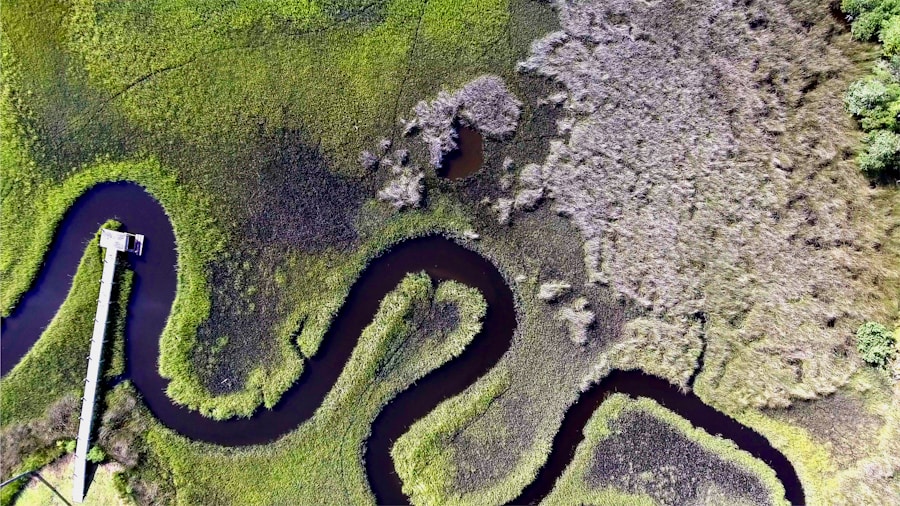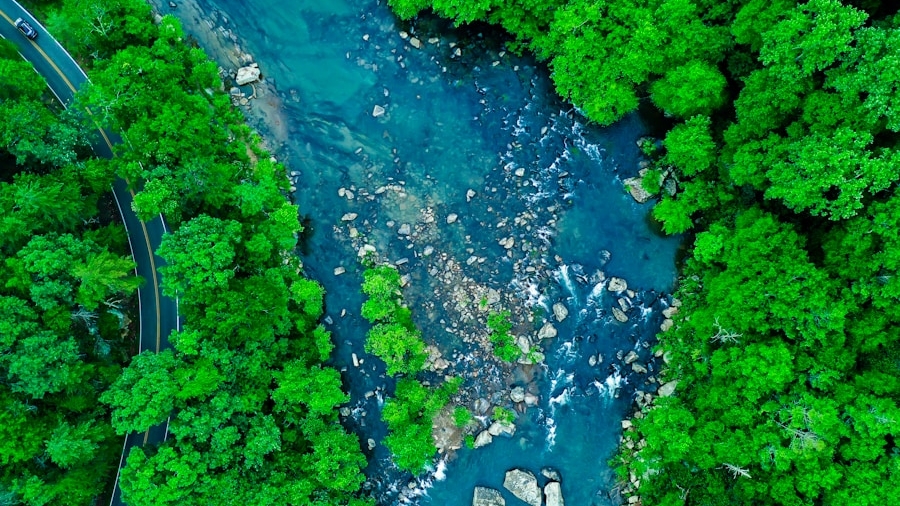Artificial Intelligence (AI) has emerged as a transformative force across various sectors, including healthcare, finance, and transportation. However, its potential to address environmental challenges, particularly in the context of natural disasters, is gaining increasing attention. Environmental disasters, such as hurricanes, wildfires, floods, and earthquakes, pose significant threats to ecosystems, human life, and economic stability.
The frequency and intensity of these disasters have escalated in recent years, largely attributed to climate change and human activities. In this landscape, AI offers innovative solutions that can enhance our understanding of environmental phenomena and improve disaster preparedness and response. The integration of AI into environmental science is not merely a technological advancement; it represents a paradigm shift in how we approach the complexities of nature.
By leveraging vast amounts of data from various sources—satellite imagery, sensor networks, and historical records—AI can identify patterns and predict outcomes with remarkable accuracy. This capability is particularly crucial in a world where the consequences of environmental disasters can be catastrophic. As we delve deeper into the role of AI in monitoring, predicting, and preventing environmental disasters, it becomes evident that this technology is not just a tool but a vital ally in safeguarding our planet.
Key Takeaways
- AI has the potential to revolutionize environmental disaster prediction and prevention by providing advanced monitoring and analysis tools.
- AI can be used to predict natural disasters such as hurricanes, earthquakes, and wildfires, allowing for better preparation and response.
- AI can help prevent environmental disasters by identifying potential risks and providing early warnings to authorities and communities.
- Case studies have shown the positive impact of AI in predicting and preventing environmental disasters, saving lives and minimizing damage.
- While AI has great potential, there are still challenges and limitations to consider, and the future of AI in environmental disaster prediction and prevention is promising but requires continued development and improvement.
AI Tools for Environmental Monitoring and Analysis
AI tools for environmental monitoring encompass a wide array of technologies designed to collect, analyze, and interpret data related to the environment. One prominent example is remote sensing technology, which utilizes satellites equipped with advanced sensors to gather data on land use, vegetation health, and atmospheric conditions. Machine learning algorithms can process this data to detect changes over time, providing insights into deforestation rates, urban expansion, and the health of ecosystems.
For instance, Google Earth Engine combines satellite imagery with machine learning to monitor deforestation in real-time, enabling conservationists to take timely action against illegal logging activities. Another significant application of AI in environmental monitoring is the use of Internet of Things (IoT) devices. These devices can be deployed in various environments to collect real-time data on air quality, water levels, soil moisture, and other critical parameters.
AI algorithms can analyze this data to identify trends and anomalies that may indicate impending environmental threats. For example, smart sensors placed in flood-prone areas can monitor water levels and predict flooding events by analyzing historical data patterns alongside real-time measurements. This proactive approach allows communities to prepare for potential disasters before they occur.
Predicting Natural Disasters with AI

The predictive capabilities of AI are particularly valuable in the context of natural disasters. Traditional methods of forecasting often rely on historical data and statistical models that may not account for the complexities of changing environmental conditions. In contrast, AI algorithms can analyze vast datasets from multiple sources—such as weather patterns, geological surveys, and oceanographic data—to generate more accurate predictions.
For instance, machine learning models have been developed to predict the likelihood of hurricanes based on atmospheric conditions and historical storm data. These models can provide early warnings that are crucial for evacuation planning and resource allocation. Moreover, AI’s ability to process unstructured data enhances its predictive power.
By analyzing tweets or posts related to specific weather events or seismic activity, AI can detect emerging trends and provide insights into public sentiment and behavior. This information can be instrumental for emergency management agencies in understanding the needs of affected populations and coordinating effective responses.
Preventing Environmental Disasters with AI
While predicting natural disasters is essential, preventing them or mitigating their impacts is equally critical.
For instance, machine learning algorithms can analyze historical data on wildfires to identify high-risk areas based on factors such as vegetation type, weather conditions, and human activity.
This information can guide land management practices and inform policies aimed at reducing fire risks in vulnerable regions. In agriculture, AI-driven precision farming techniques can help prevent environmental degradation by optimizing resource use. By analyzing soil health data and weather forecasts, farmers can make informed decisions about irrigation, fertilization, and pest control.
This not only enhances crop yields but also minimizes the environmental impact of agricultural practices. For example, companies like Climate Corporation utilize AI to provide farmers with tailored recommendations that promote sustainable farming practices while reducing the risk of soil erosion and water pollution.
Case Studies: AI’s Impact on Environmental Disaster Prediction and Prevention
Several case studies illustrate the profound impact of AI on environmental disaster prediction and prevention. One notable example is the use of AI in predicting landslides in mountainous regions. Researchers at the University of Southern California developed a machine learning model that analyzes topographical data, rainfall patterns, and soil moisture levels to predict landslide occurrences with high accuracy.
This model has been implemented in various regions prone to landslides, providing local authorities with critical information to issue timely warnings and implement preventive measures. Another compelling case study involves the application of AI in managing wildfires in California. The state has faced devastating wildfires in recent years, prompting the need for innovative solutions.
The California Department of Forestry and Fire Protection (Cal Fire) has adopted AI-driven tools that analyze satellite imagery and weather data to predict fire behavior and spread. By integrating these predictions into their operational strategies, firefighting agencies can allocate resources more effectively and prioritize areas for controlled burns or other preventive measures.
Challenges and Limitations of AI in Environmental Disaster Prediction

Despite its potential benefits, the application of AI in environmental disaster prediction is not without challenges. One significant limitation is the quality and availability of data. AI algorithms rely heavily on large datasets for training; however, in many regions, especially developing countries, comprehensive environmental data may be scarce or outdated.
This lack of reliable data can hinder the accuracy of predictions and limit the effectiveness of AI tools. Additionally, there are ethical considerations surrounding the use of AI in disaster management. The reliance on automated systems raises questions about accountability and transparency.
In situations where AI-generated predictions lead to significant decisions—such as evacuations or resource allocations—there must be mechanisms in place to ensure that these decisions are made responsibly and ethically. Furthermore, biases inherent in training data can lead to skewed predictions that disproportionately affect certain communities or demographics.
The Future of AI in Environmental Disaster Prediction and Prevention
Looking ahead, the future of AI in environmental disaster prediction and prevention appears promising yet complex. As technology continues to evolve, we can expect advancements in machine learning algorithms that enhance predictive accuracy and efficiency. The integration of AI with other emerging technologies—such as blockchain for data integrity or augmented reality for visualization—could further revolutionize how we approach disaster management.
Moreover, fostering collaboration between governments, research institutions, and private companies will be crucial for maximizing the potential of AI in this field. By sharing data and resources, stakeholders can develop more robust models that account for regional variations in environmental conditions. Additionally, investing in education and training programs will ensure that professionals are equipped with the skills needed to leverage AI effectively in disaster management.
The Role of AI in Safeguarding the Environment
As we navigate an era marked by increasing environmental challenges, the role of AI in safeguarding our planet cannot be overstated. From monitoring ecosystems to predicting natural disasters and implementing preventive measures, AI technologies offer innovative solutions that enhance our ability to respond to environmental threats. While challenges remain—particularly regarding data quality and ethical considerations—the potential benefits far outweigh the limitations when harnessed responsibly.
The ongoing development of AI tools tailored for environmental applications will undoubtedly shape our approach to disaster management in the coming years. By embracing these technologies and fostering collaboration across sectors, we can create a more resilient future that prioritizes both human safety and ecological sustainability. In this context, AI stands not only as a technological advancement but as a critical partner in our efforts to protect the environment for generations to come.
In a related article, Smartsender: Your Chatbot Platform for Seamless Customer Interactions, explores how artificial intelligence is being used to enhance customer interactions and improve overall user experience. Just as AI is being utilized to predict and prevent environmental disasters, it is also being leveraged in the realm of customer service to streamline communication and provide more efficient support. The advancements in AI technology are truly revolutionizing various industries and transforming the way we interact with our environment and each other.
FAQs
What is AI?
AI, or artificial intelligence, refers to the simulation of human intelligence in machines that are programmed to think and act like humans. This includes tasks such as learning, problem-solving, and decision-making.
How is AI being used to predict environmental disasters?
AI is being used to analyze large amounts of data from various sources such as satellite imagery, weather patterns, and historical data to identify patterns and trends that could indicate an impending environmental disaster. This allows for early warning systems to be put in place and for preventive measures to be taken.
What are some examples of how AI is being used to prevent environmental disasters?
AI is being used to predict and prevent forest fires by analyzing data on weather conditions, vegetation, and human activity to identify areas at high risk. It is also being used to monitor and manage water resources by analyzing data on water levels, quality, and usage to prevent droughts and water shortages.
What are the benefits of using AI to predict and prevent environmental disasters?
Using AI to predict and prevent environmental disasters can help save lives, protect property, and preserve natural resources. It allows for more proactive and targeted interventions, leading to more effective disaster management and mitigation efforts.
Are there any limitations to using AI for predicting and preventing environmental disasters?
While AI can analyze large amounts of data and identify patterns, it is not foolproof and may not be able to account for all variables and factors that contribute to environmental disasters. Additionally, the effectiveness of AI in disaster prevention relies on the availability and accuracy of data.

